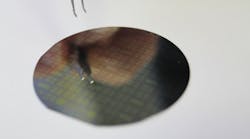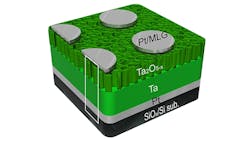Researchers from Rice University have produced a nonvolatile, resistive random access memory (RRAM) technology that provides high-density storage in crossbar memory arrays. The solid-state memory is based on tantalum oxide, a material commonly used in capacitors for mobile devices and computers.
Each 3D memory cell supports up to 162 gigabits or 20 gigabytes of information, using highly resistive materials to increase the density of the memory between each crossbar. The cells are built with layers of graphene, tantalum, and nanoporous tantalum oxide, all of which are pressed in between two platinum electrode crossbars.
The research team found that applying a control voltage to the 250-nanometer-think stack creates addressable bits where the layers meet. The control voltage that writes and rewrites the cell is adjustable, according to the research team, although the crossbars are not dense enough to address individual bits.
The memory is based on a two-terminal material that requires only two electrodes per circuit, in contrast to the three electrodes used in current flash memories. The research, which appeared in the journal Nano Letters, said that the memory could be fabricated at room temperature. It is also capable of running on 100 times less energy than present devices, the researchers claimed, resulting in better endurance and durability.
The memory’s switching ability is the result of oxygen ions moving between vacancies in the stack. The control voltage sent through the cell causes a boundary within the material to transform into a Schottky contact. This contact barrier changes its function based on the way oxygen vacancies shift within the cell, said Gunuk Wang, the lead author of the research paper and assistant professor at Korea University.
At the same time, the flow of electrical current draws oxygen ions from the tantalum oxide nanopores. As they pass through the material, these particles create a tantalum filament that connects the platinum electrodes on either end of the stack—writing the cell as a “one”. In addition, these oxygen ions produce an electric field that effectively serves as a diode, reducing crosstalk that would otherwise allow the bits to be misread.
The tantalum-oxide memory has several hurdles to commercialization: the researchers are trying to make the crossbar arrays more dense and find ways to control the size of the nanopores. Other authors of the research paper were assistant professor of mechanical and industrial engineering Jae-Hwang Lee, and Rice postdoctoral researchers Yang Yang, Gedeng Ruan, Nam Dong Kim, and Yongsung Ji.

